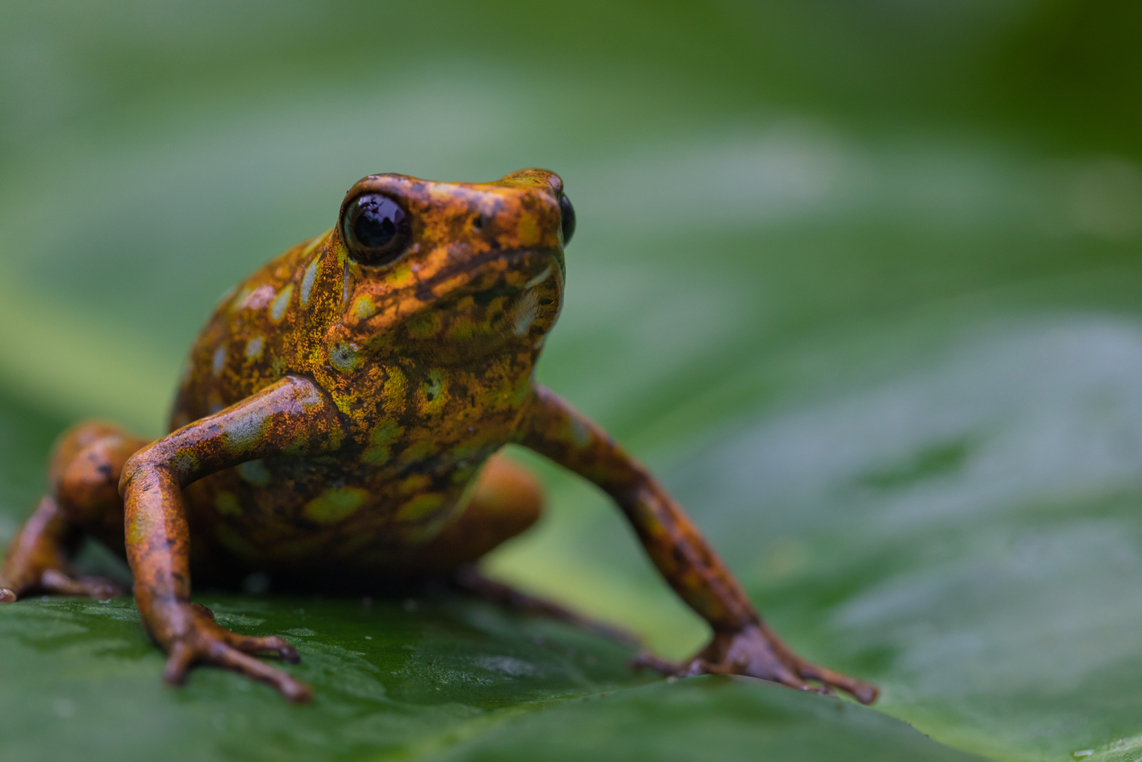As recent research suggests, the skin of many frogs is a potential global pharmacopeia for the treatment of certain medical conditions such as pain or Alzheimer’s Disease(1). It is this characteristic, a remarkable skin, that draws attention to anyone who runs into a frog of the Dendrobatidaefamily. Commonly known as Poison Frogs, many of the species in this large family have a very vivid skin color that warns its predators of highly toxic or, at least, irritant substances present in the outer layer of their bodies. This phenomenon, called aposematic coloration(2),is what hypnotized many people like us, germinating in our interior a real passion and dedication for these delicate beings.
In March 2016, during a trip to Panama in search of the different morphotypes of Oophaga pumilioin their natural environment, we had the opportunity to observe how their habitat was being destroyed. Trees 30 meters high, whose trunks were home to countless lives were being cut down to open new routes through almost virgin forest to build houses to the increasing demand for accommodations for wealthy people who wanted a home in paradise. A paradise that, ironically, was being destroyed to (un)welcome them. With each tree felled, hundreds of species including plants, invertebrates, birds, reptiles and amphibians, were stripped of their true Eden forever. In the depth of that panorama, we continued to hear the cry of the howler monkeys (Allouatta palliata) and the claims of the strawberry poison frog (Oophaga pumilio). Our perspective changed during that trip. We could not help feeling the weight of a gray pessimism on our backs. Towards the end of our trip, we realized that there was some hope: a biological station, a recycling plant in the middle of the main island and even an ecological coffee farm whose owner had deliberately increased the number of bromeliads in his lands to favor the reproduction of dendrobatids in the area. Something could be done, and we were willing to contribute. At that time, we started recording what we saw and what we would like to be changed. Maybe a post on a social network could work, perhaps a campaign on any platform could gain enough strength… but why not to propose a crowdfunded project that unites poison frogs fans and those with initiatives and active projects to save these very specific amphibians? And that’s how Poison Dart Frogs, The Documentary Project was born. It has now gone further than we could have imagined at that time.
Thanks to the support received by all those people who believed that telling this story could provide that grain of sand so fundamental for changes to be possible, we undertook an unprecedented trip in our lives with the ultimate goal of making an audiovisual project to show how different initiatives are saving dendrobatids: from BioTrade as an alternative to black and grey amphibian markets(3), to ex situand in situconservation at amphibian arks and private reserves, respectively.
References:
- Oliveira Filho, Ronaldo E. de, & Omori, Alvaro T.. (2015). Recent Syntheses of Frog Alkaloid Epibatidine. Journal of the Brazilian Chemical Society, 26(5), 837-850. https://dx.doi.org/10.5935/0103-5053.20150045
- Kathleen L. Prudic, Ana K. Skemp, Daniel R. Papaj (2007); Aposematic coloration, luminance contrast, and the benefits of conspicuousness, Behavioral Ecology, 18(1), 41–46, https://doi.org/10.1093/beheco/arl046
- United Nations Conference on Trade and Development, https://unctad.org/biotrade(2019)
Acknowledgments:
I am grateful to all our 101 Kickstarter backers. Thanks to Brian Kubicki (director of C.R.A.R.C), Candace M. Hansen-Hendrikx (Director of Operations Amphibian Survival Alliance), Carlos Galvis (Head of the Section of the Biology Area of the Zoological Foundation of Cali), Dendrobates España, Giovanni Chaves (Fundación Ecodiversidad Colombia), Giovanni Onore (Founder of Otonga Foundation), Josh’s Frogs, La Y Griega, Lola Guarderas (General Manager of Wikiri), Luis Coloma (Director of Jambatu Center) and Mist King. This project would not be possible without Jane Goodall’s reasons for hope.
By Andrés Piolatti (director of Poison Dart Frogs, The Documentary Project)
Photo © Photo: Andrés Piolatti

